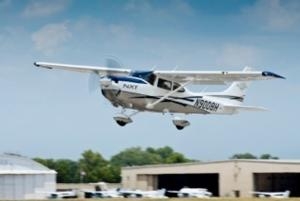Wed, Aug 15, 2012
Says New Moniker Better Reflects 'Innovative Features' Of The Updated Plane
Cessna is renaming its newest single engine product. The jet-fuel burning turbo aircraft introduced at Oshkosh last month as the Turbo Skylane NXT will now be called the Turbo Skylane JT-A (aircraft pictured in image from Cessna).

As confirmed by customer feedback at Oshkosh, the name Turbo Skylane JT-A better captures and reflects the innovative features of the new plane than the NXT designation. It was also brought to Cessna's attention shortly after the announcement of the Turbo Skylane NXT that there was a previous use of the NXT name in the aviation industry of which Cessna had not been aware. Cessna both respects the trademark rights of others and desires to obtain registered trademark status on its name for this important new product.
In introducing the aircraft at Oshkosh, Cessna said that the Turbo 182 is a result of market research and has already undergone extensive reliability testing, as well as flight testing. The Safran-made SMA engine is engineered specifically for aviation and is already FAA and EASA certified. The engine uses only 11 gallons per hour of the typically lower-cost Jet A fuel at the estimated maximum cruise speed of 155 knots.
“Operators can now take advantage of the wider availability of Jet A with the potential to fly farther on one gallon of gas than you can with traditional avgas aircraft,” Umscheid said. “This is a game-changer that opens up new markets and new regions of the world due to its versatility and performance.”
The fuel technology used in this engine eliminates concerns about carbon monoxide emissions, fuel mixtures, propeller control and exhaust gas. The engine operates at a lower propeller speed. As a result, the turbocharger technology delivers a quieter flight line and reduces noise pollution. There are zero lead emissions and zero CO emissions. Flight at the maximum cruise speed demonstrates greater fuel efficiency, and will burn approximately 30 percent to 40 percent less fuel than comparable avgas engines.
More News
Light Gun A handheld directional light signaling device which emits a brilliant narrow beam of white, green, or red light as selected by the tower controller. The color and type of>[...]
"The journey to this achievement started nearly a decade ago when a freshly commissioned Gentry, driven by a fascination with new technologies and a desire to contribute significan>[...]
Aero Linx: JAARS, Inc. For decades now, we’ve landed planes on narrow rivers and towering mountains. We’ve outfitted boats and vehicles to reach villages that rarely se>[...]
"Our driven and innovative team of military and civilian Airmen delivers combat power daily, ensuring our nation is ready today and tomorrow." Source: General Duke Richardson, AFMC>[...]
Aircraft Conflict Predicted conflict, within EDST of two aircraft, or between aircraft and airspace. A Red alert is used for conflicts when the predicted minimum separation is 5 na>[...]
 ANN's Daily Aero-Term (04.20.24): Light Gun
ANN's Daily Aero-Term (04.20.24): Light Gun Aero-News: Quote of the Day (04.20.24)
Aero-News: Quote of the Day (04.20.24) ANN's Daily Aero-Linx (04.21.24)
ANN's Daily Aero-Linx (04.21.24) Aero-News: Quote of the Day (04.21.24)
Aero-News: Quote of the Day (04.21.24) ANN's Daily Aero-Term (04.21.24): Aircraft Conflict
ANN's Daily Aero-Term (04.21.24): Aircraft Conflict



